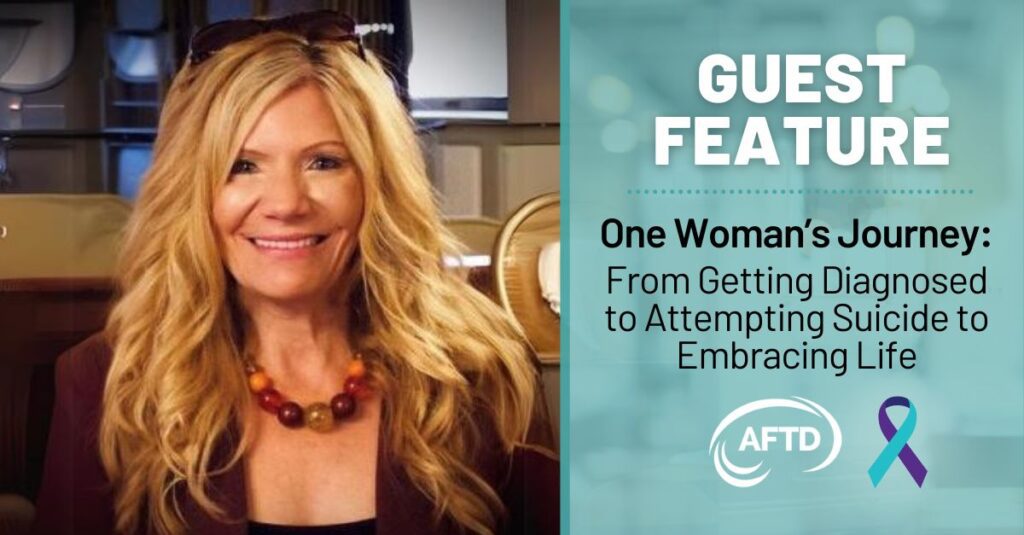Gästinslag: One Woman's Journey – från att få diagnosen till att försöka begå självmord till att omfamna livet

September är självmordsförebyggande månad. Nedan, Deb Jobe, medlem av AFTD:s personer med FTD Advisory Council, delar modigt med sig av historien om hennes självmordsförsök efter en FTD-diagnos, och hur hon återvände från att vilja avsluta sitt liv till att helt omfamna det.
När jag sitter här på min bakgård och känner solens värme, tittar på kolibrierna som glider från matare till matare och lyssnar på naturens musik, inser jag hur välsignad jag är. Jag säger detta trots att det fanns en period i mitt liv då jag kände mig överväldigad, förlorad, så ensam och utan värde. Varför? Jag fick diagnosen FTD i samband med kortikobasalt syndrom.
Jag minns tydligt att jag satt med min man när neurologen gick igenom mina tester och ställde diagnosen. Vår värld rasade omkring oss. Tusen tankar for genom mitt huvud och en överväldigande förtvivlan satte sig i mitt hjärta. Det här är inte en sjukdom som finns i min familj.
Inom sex månader efter diagnosen kände jag att det inte fanns något att leva för. Orolig för att jag skulle bli en börda för min familj (känslomässigt och ekonomiskt) och förlora mitt oberoende (inte mer att köra bil, laga mat eller cykla) och inför plötslig pensionering från en 34-årig karriär som jag älskade, försökte jag begå självmord.
Många studier har visat att personer med demens, och FTD specifikt, har en förhöjd risk för självmordstankar och självmordsbeteenden:
- En studie av den amerikanska veteranbefolkningen som publicerades 2018 i American Journal of Geriatric Psychology fann att personer med FTD uppvisade suicidalt beteende oftare än personer som diagnostiserades med andra former av demens.
- Under 2019 publicerade American Journal of Alzheimer's Disease and Other Dementias en studie som fann att 40 procent av personer som diagnostiserats med beteendevariant FTD hade självmordstankar, jämfört med bara 8 procent av en odiagnostiserad kontrollgrupp.
- År 2021 fann en psykologi- och hälsostudie att självmordsfrekvensen för personer som lever med FTD eller Huntingtons sjukdom var 2 996 per 100 000 personer, mycket högre än självmordsfrekvensen för den allmänna befolkningen (10 av 100 000).
Tack och lov att jag, trots mitt självmordsförsök, fortfarande är här. Idag lever jag bra, njuter av dyrbar tid med min familj och upptäcker nya aktiviteter varje dag!
Människor som diagnostiserats med sjukdom som är så livsförändrande som FTD kan uppleva depression, stress, isolering och hopplöshet som kan leda till självmordstankar, med yngre individer som upplever en högre frekvens av sådana tankar. Jag är ett levande exempel på detta. Jag fick diagnosen för fyra år sedan vid 53 års ålder.
Hur återhämtade jag mig från självmordsförsök? En mängd support och tjänster. Det påminner mig om talesättet, "Det krävs en by..." Min neurolog och primärvårdsläkare gav remisser för:
- Löpande rådgivning
- Kognitiv/beteendebaserad logopedi
- Sjukgymnastik och arbetsterapi
Vi använde också värdefulla resurser från Association for Frontotemporal Degeneration (i synnerhet rekommenderar hjälplinjen: 1-866-507-7222 eller info@theaftd.org). Dessutom gav stödgrupper möjlighet att prata med andra som förstod. Vi använde också bön och vår tro för att vägleda oss.
Jag började inse att livet inte är hopplöst: jag är fortfarande jag och kan bidra. Nästan fyra år senare tänker jag nu på mitt liv efter diagnosen som en resa. Resor sträcker sig över en tidsperiod och varje resa är unik och fortskrider olika för varje person.
Mitt liv har blivit enklare, långsammare och jag tycker mer om de små sakerna. När negativa tankar börjar krypa tillbaka går jag tillbaka till rådgivning. Det finns INGEN SKAM när dessa tankar uppstår! DU ÄR INTE ENSAM!
Om du eller en nära och kära märker förändringar hos personen som lever med demens (PLWD), kontakta din läkare för hjälp och kontakta AFTD.
Vi är människor som lever med demens, och vi kan fortfarande leva!
Om du har självmordstankar, ring eller sms:a 988 för att nå 988 Suicide and Crisis Lifeline. Du kan också besöka webbplatsen för International Association of Suicide Prevention för mer resurser.
Efter kategori
Våra nyhetsbrev
Hållas informerad
Registrera dig nu och håll koll på det senaste med vårt nyhetsbrev, evenemangsvarningar och mer...
